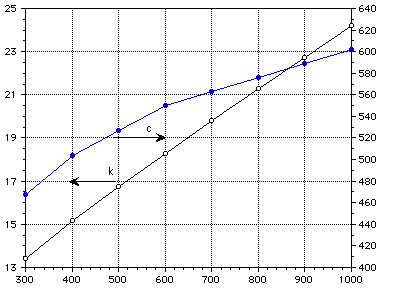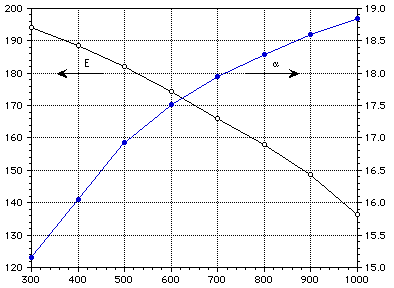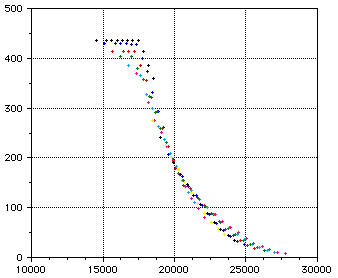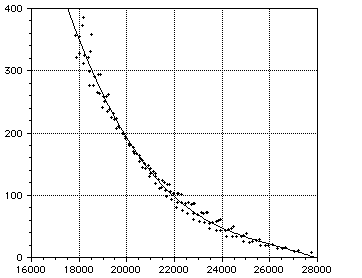 (1)
(1)
The structural material for the first wall and blanket of a fusion device must be of excellent integrity with well known and established properties since it will be subjected to radiation damage levels ~10-7 dpa/s, will be expected to operate at temperatures in the range of 100-600 C and for pulsed machines will be subject to damage caused by thermal fatigue as a result of the cyclic strains produced by the temperature changes during intermittent burning of the plasma.
Austenitic steel of the 316 type has been selected as a potential structural material for near term fusion experimental devices. Austenitic stainless steel has been studied in many nuclear environments, therefore a substantial amount of data is available.
Compatibility
The compatibility of stainless steel with coolant materials has been judged almost exclusively in terms of the "wastage" or thinning of the material. On this basis a corrosion rate of approximately 25 um/year (~1 mpy) is actually taken as the acceptable upper bound for blanket or coolant compatibility.
Compatibility with liquid lithium is under question principally because the available corrosion data for lithium are limited. The compatibility of sodium with austenitic stainless steels is more feasible than that of lithium. Helium as an inert coolant provides no compatibility problems.
GENERAL PROPERTIES - 316 SS [1]
Chemical composition of 316ss stainless steel (wt %)
C Si Mn P S Cr Ni Mo Ti N Al Co Nb 0.055 0.75 1.5 0.02 0.004 16.4 13.9 2.3 0.08 0.0084 0.021 0.013 0.06
Physical Properties
Density : 7.96 g/cm3
Melting Point : 1370 - 1400 C
Electrical Properties
Electrical Resistivity : 70 - 78 u [[Omega]] cm
Thermal Properties
Coefficient of Expansion @ 20 - 100 C : 16 - 18x10-6
m/m-K
Thermal Conductivity @ RTP : 16.3 W/m-K
Mechanical Properties
Brinell Hardness : 160 - 190
Elongation : < 60 %
Izod Impact : 20 - 136 J m-1
>Modulus of Elasticity : 190 - 120 GPa
Tensile Strength : 460 - 860 MPa
DATA AND CORRELATIONS
The thermal and structural properties as a function of temperature are presented in Table 1, refs [2, 3, 4, 5, 6]. Polynomial correlations of the thermal and structural properties as functions of temperature, using the data of Table 1, are as follows:
 (1)
(1)
 (2)
(2)
 (3)
(3)
 (4)
(4)
 (5)
(5)
with T in kelvin and Eqs 1-5 valid in the temperature range of 300-1000 K. Figures 1-4 show the variation of properties with temperature. The data of stress to rupture with respect to time (hours) and temperature (K) are grouped into a master curve using the Larson-Miller parameter P defined as follows:
 (6)
(6)
with T the temperature in K, c=20 a constant and t the time in hours.
Figure 4 shows the master curve of the Larson-Miller Parameter for Type 316 SS for the temperature range 700 K-1100 K and time range of 1-3x105 hr [4]. Figure 5 shows the values restricted to P>=17,825. A line of best fit is as follows:
 (7)
(7)
TABLE 1 Thermal and structural properties of 316 SS
T K [[rho]] E GPa [[nu]] k W/m-K c kJ/kg-K [[sigma]] [[alpha]]
kg/m3 y MPa (10-6)
m/m-K
300 8238.0 194.18 0.270 13.40 468.0 206.85 15.156
400 188.49 15.20 504.0 167.49 16.051
500 182.02 16.75 527.0 143.38 16.933
600 174.29 18.30 550.0 128.64 17.511
700 166.17 19.80 563.0 121.36 17.946
800 157.96 21.30 576.0 117.62 18.297
900 148.63 22.75 589.0 112.52 18.592
1000 136.50 24.20 602.0 102.99 18.847
k (W/m-K) c (J/kg-k)

Temperature (K)
Figure 1 : Thermal conductivity and specific heat of type 316 SS.
E (GPa) [[alpha]] (10-6 m/m-K)

Temperature (K)
Figure 2 : Elastic modulus and coefficient of thermal expansion of type 316
SS.

Temperature (K)
Figure 3 : Yield stress of type 316 stainless steel.

Larson Miller Parameter (P)
Figure 4 : Stress-to-rupture variation with the Larson-Miller parameter of type
316 stainless steel.
Stress-to-Rupture (MPa)

Larson Miller Parameter (P)
Figure 5 : Larson-Miller parameter versus stress to rupture.